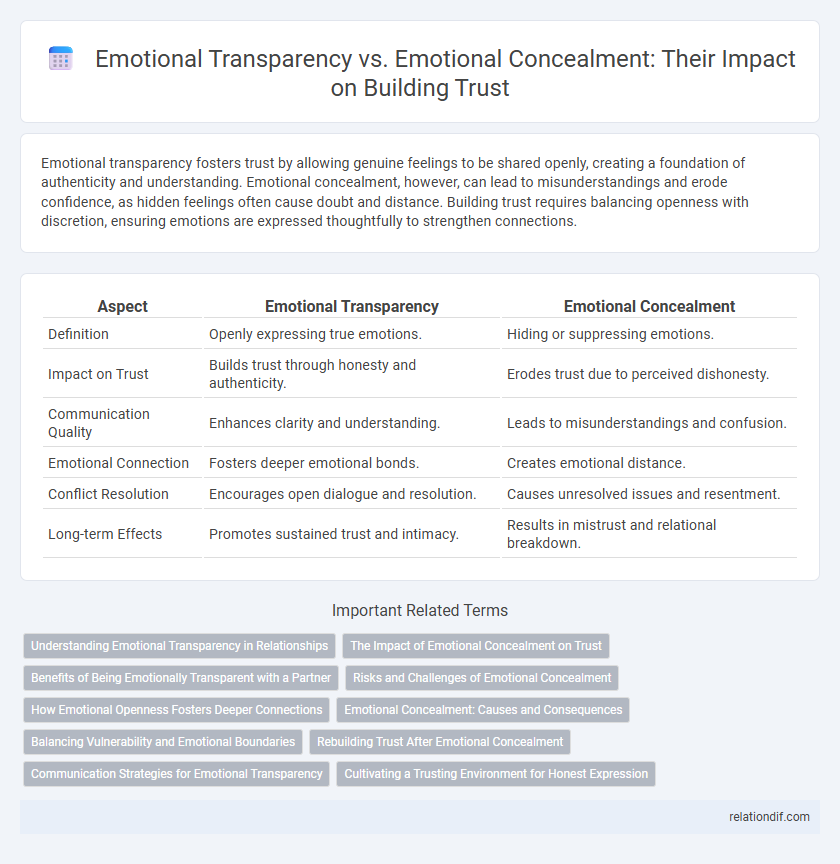Emotional transparency fosters trust by allowing genuine feelings to be shared openly, creating a foundation of authenticity and understanding. Emotional concealment, however, can lead to misunderstandings and erode confidence, as hidden feelings often cause doubt and distance. Building trust requires balancing openness with discretion, ensuring emotions are expressed thoughtfully to strengthen connections.
Table of Comparison
| Aspect | Emotional Transparency | Emotional Concealment |
|---|---|---|
| Definition | Openly expressing true emotions. | Hiding or suppressing emotions. |
| Impact on Trust | Builds trust through honesty and authenticity. | Erodes trust due to perceived dishonesty. |
| Communication Quality | Enhances clarity and understanding. | Leads to misunderstandings and confusion. |
| Emotional Connection | Fosters deeper emotional bonds. | Creates emotional distance. |
| Conflict Resolution | Encourages open dialogue and resolution. | Causes unresolved issues and resentment. |
| Long-term Effects | Promotes sustained trust and intimacy. | Results in mistrust and relational breakdown. |
Understanding Emotional Transparency in Relationships
Emotional transparency in relationships involves openly sharing feelings and thoughts, fostering a foundation of trust and deep connection between partners. This practice enhances emotional intimacy and reduces misunderstandings by allowing individuals to express vulnerabilities authentically. In contrast, emotional concealment can lead to barriers in communication and a gradual erosion of mutual trust over time.
The Impact of Emotional Concealment on Trust
Emotional concealment significantly undermines trust by creating barriers to genuine connection and fostering suspicion. When individuals hide their true feelings, it disrupts open communication, leading others to question their authenticity and reliability. This erosion of trust can result in strained relationships and diminished emotional intimacy over time.
Benefits of Being Emotionally Transparent with a Partner
Being emotionally transparent with a partner strengthens trust by fostering open communication and mutual understanding, which deepens emotional intimacy. This vulnerability enhances relationship resilience, enabling couples to navigate conflicts with empathy and reduce misunderstandings. Emotional transparency promotes psychological safety, encouraging authenticity and long-term connection.
Risks and Challenges of Emotional Concealment
Emotional concealment increases risks of miscommunication and erodes trust by creating barriers to authentic connection. Suppressing feelings can lead to unresolved conflicts, heightened stress, and emotional exhaustion, undermining relationship stability. Long-term concealment fosters misunderstandings that challenge empathy and mutual support essential for trust-building.
How Emotional Openness Fosters Deeper Connections
Emotional openness enhances trust by allowing individuals to express vulnerability and authentic feelings, which strengthens interpersonal bonds and promotes empathy. Transparent communication reduces misunderstandings and builds a foundation of mutual respect, crucial for sustainable relationships. Consistent emotional sharing encourages reciprocal honesty, deepening connections and fostering a supportive environment.
Emotional Concealment: Causes and Consequences
Emotional concealment stems from fear of vulnerability, social stigma, or past trauma, leading individuals to hide their true feelings to protect themselves from judgment or rejection. This suppression often results in increased stress, weakened interpersonal relationships, and a diminished sense of authenticity, which ultimately erodes trust between individuals. Chronic emotional concealment disrupts effective communication and fosters emotional isolation, impairing emotional well-being and the development of deep, meaningful connections.
Balancing Vulnerability and Emotional Boundaries
Balancing vulnerability and emotional boundaries is essential for building trust, as emotional transparency fosters genuine connections while preventing overexposure that may lead to discomfort or betrayal. Effective emotional transparency involves sharing feelings authentically yet discerningly, ensuring communication remains respectful and constructive. Establishing clear emotional boundaries protects personal well-being, maintaining trust through consistent, honest interactions without sacrificing privacy or self-respect.
Rebuilding Trust After Emotional Concealment
Rebuilding trust after emotional concealment requires consistent emotional transparency to demonstrate honesty and vulnerability. Open communication fosters a safe environment where feelings can be expressed without fear of judgment, gradually restoring confidence. Studies show that transparent emotional expression significantly improves relational trust and reduces anxiety between partners.
Communication Strategies for Emotional Transparency
Effective communication strategies for emotional transparency include expressing feelings honestly and clearly while maintaining respect and empathy. Utilizing active listening techniques fosters mutual understanding, encouraging openness and reducing misunderstandings in relationships. Nonverbal cues such as consistent eye contact and open body language reinforce trust and authenticity during emotionally transparent exchanges.
Cultivating a Trusting Environment for Honest Expression
Emotional transparency fosters trust by encouraging open and honest expression, creating a safe space where individuals feel valued and understood. Embracing vulnerability in communication reduces misunderstandings and strengthens relational bonds within teams and organizations. Prioritizing emotional openness over concealment enhances psychological safety, leading to increased collaboration, empathy, and overall trustworthiness.
Emotional transparency vs emotional concealment Infographic

 relationdif.com
relationdif.com